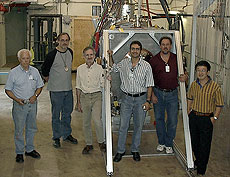Illinois Institute of Technology
 |
| Illinois Institute of Technology's Yagmur Torun (middle) stands with Bob MacGill of Lawrence Berkeley National Laboratory (left), Barry Norris of Fermilab, Alan Bross of Fermilab, Michael Dickerson of Lawrence Berkeley National Laboratory and Derun Li of Lawrence Berkeley National Laboratory (right) at the MUCOOL test area at Fermilab. |
NAME:
Illinois Institute of Technology
HOME TOWN:
Chicago
MASCOT:
Scarlet hawk
SCHOOL COLORS:
Scarlet and gray
PARTICLE PHYSICS COLLABORATIONS:
Daya Bay, Double Chooz, E299, E545, E570, E594, E632, E791, HyperCP, MICE, MINOS, MIPP, MuCool and pbar
EXPERIMENTS AT FERMILAB:
HyperCP, MINOS, MIPP and MuCool experiments
SCIENTISTS AND STUDENTS AT FERMILAB:
Two postdocs, nine scientists, two graduate students and one undergraduate
COLLABORATING AT FERMILAB SINCE:
1972
MAJOR CONTRIBUTIONS TO FERMILAB EXPERIMENTS:
HyperCP data acquisition system; E791, HyperCP and MINOS software management and MuCool Test Area instrumentation. IIT also built and maintained the holographic replay system for E-632, the 15-foot bubble chamber with holography, which searched for tau neutrino appearance from interactions in the bubble chamber that produced tau particles.
PARTICLE PHYSICS RESEARCH FOCUS:
Neutrinos, heavy quarks, CP violation and rare decays
WHAT SETS PARTICLE PHYSICS AT IIT APART?
Our proximity to Fermilab allows IIT students and scientists to easily participate in activities and projects centered at either the laboratory or our home campus. Our faculty can maintain a high-duty-factor on-site laboratory presence while meeting our university obligations. Our students can be based at the laboratory while maintaining close contact with their adviser and home institution.
FUNDING AGENCY:
Department of Energy, National Science Foundation
FAVORITE NATIONAL LABORATORY:
Fermilab

View all University profiles
|